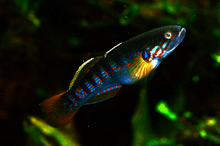Mogurnda
| Mogurnda | ||||||||||||
|---|---|---|---|---|---|---|---|---|---|---|---|---|

Purple-dotted sleeper goby ( Mogurnda adspersa ) |
||||||||||||
| Systematics | ||||||||||||
|
||||||||||||
| Scientific name | ||||||||||||
| Mogurnda | ||||||||||||
| Gill , 1863 |
The genus Mogurnda is home to around two dozen freshwater goby species from the sleeper goby family . They are only found in Australia and New Guinea. The genus name Mogurnda comes from the name for the fish used by some Aborigines in the Northern Territory.
features
Typically for sleeper gobies, the species from the genus Mogurnda also have an elongated body with a cylindrical cross-section. The body length is about 8 to 14 cm, based on the body size, these gobies have a normal sized mouth. Mogurnda can be easily distinguished from other goby genera by red dots on the bluish long sides of the body, often in connection with a row of five to ten light or yellowish short vertical stripes. The fins are usually also red dotted at the base of the fin with an outer yellowish band. There is little difference between males and females. Males usually have slightly longer and larger dorsal and anal fins. They can have more red spots and a squat head. Likewise, the different species within the genus are difficult to distinguish by color.
Occurrence
The genus occurs in fresh water in northern, eastern and central Australia and New Guinea, with the exception of the Vogelkop Peninsula in the far west. The distribution areas of the 6 Australian species do not seem to overlap. While Mogurnda adspersa and Mogurnda mogurnda each have a large distribution area in the north (as well as in southern New Guinea) and east of Australia, the other 4 Australian species ( Mogurnda clivicola , M. larapintae , M. oligolepis and M. thermophila ) are only very local limited, mostly in the interior of the continent and are therefore endangered.
Of the 20 species from New Guinea described, some also have a large distribution area, while others only occur locally, such as the 7 species from Lake Kutubu .
Habitat
These sleeper gobies are found in various freshwater habitats such as rivers, streams, billabongs or lakes. These lurking hunters can usually be found in slow-flowing, calm stretches of water protected by underwater vegetation or roots. In faster flowing waters they stay between larger stones, which offer protection from predators as well as protection from the current and are used as spawning grounds. Young fish often stay in very shallow water near the shore, while adult fish are usually found in water depths of half a meter to one meter.
Reproduction
Knowledge about reproduction is mainly available from aquarium observations. Reproduction is easy with good feeding and temperatures above 20 ° C. The females lay a few hundred to over a thousand eggs on or under a hard substrate, where they are fertilized by the male. The male guards the clutch until it hatches and fans it with its pectoral fins. The larvae hatch after one to one and a half weeks. With a body length of about 5 cm, the fish become sexually mature.
Systematics
While the two widespread Australian species were scientifically described as early as the end of the 19th century, most species descriptions (by ichthyologist Gerald Allen ) were not made until the 1980s.
- Purple-dotted sleeper goby ( Mogurnda adspersa ) (Castelnau, 1878)
- Mogurnda aiwasoensis Allen & Renyaan, 1996
- Mogurnda arguni Allen & Hadiaty, 2014
- Mogurnda aurifodinae Whitley, 1938
- Mogurnda cingulata Allen & Hoese, 1991
- Mogurnda clivicola Allen & Jenkins, 1999
- Mogurnda furva Allen & Hoese, 1986
- Mogurnda kaifayama Allen & Jenkins, 1999
- Mogurnda kaimana Allen & Hadiaty, 2014
- Mogurnda kutubuensis Allen & Hoese, 1986
- Mogurnda larapintae (Zietz, 1896)
- Mogurnda lineata Allen & Hoese, 1991
- Mogurnda maccuneae Jenkins, Buston & Allen, 2000
- Mogurnda magna Allen & Renyaan, 1996
- Mogurnda malsmithi Allen & Jebb, 1993
- Mogurnda mbuta Allen & Jenkins, 1999
- Mogurnda mogurnda (Richardson, 1844)
- Mogurnda mosa Jenkins, Buston & Allen, 2000
- Mogurnda oligolepis Allen & Jenkins, 1999
- Mogurnda orientalis Allen & Hoese, 1991
- Mogurnda pardalis Allen & Renyaan, 1996
- Mogurnda pulchra Horsthemke & Staeck, 1990
- Mogurnda spilota Allen & Hoese, 1986
- Mogurnda thermophila Allen & Jenkins, 1999
- Mogurnda variegata Nichols, 1951
- Mogurnda vitta Allen & Hoese, 1986
- Mogurnda wapoga Allen, Jenkins & Renyaan, 1999
swell
- Glenn Briggs: Australian Purple-spotted Gudgeons . In: Fishes of Sahul . tape 23 , no. 3 , 2009, p. 532-535 .
- G. Allen, S. Midgley, M. Allen: Field Guide to the Freshwater Fishes of Australia . 2nd Edition. Western Australian Museum, Perth 2003, ISBN 0-7307-5486-3 , pp. 305-310 .
Web links
- Mogurnda on Fishbase.org (English)
- Overview of the genre by Adrian Tappin (in English)
